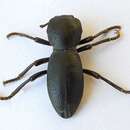Comprehensive Description
provided by Smithsonian Contributions to Zoology
Zopherus gracilis Horn
Zopherus gracilis Horn, 1867:162; 1870:272.
Zopherodes pudens Casey, 1907a:40 [new synonymy].
Zopherodes caudalis Casey, 1907a:41 [new synonymy].
Zopherodes lugubris Casey, 1907a:41; 1911:254 [new synonymy].
Zopherodes pruddeni Casey, 1907a:41 [new synonymy].
Zopherodes luctuosus Casey, 1907a:41 [new synonymy].
Zopherodes elongatus Casey, 1907b:466 [new synonymy].
Zopherodes geminatus Casey, 1907b:467 [new synonymy].
This is the smoothest known member of the genus Zopherus. Typically, the elytra are smooth but may have fine, remotely spaced punctures and scattered, randomly arranged wavy incised lines. This species occurs from the Grand Canyon area of Arizona to southeastern Arizona, southwestern New Mexico, and into at least northern Sonora, Mexico. It is especially abundant in the Chiricahua Mountain area, where sizable series have been taken at night on bark of pine.
Z. gracilis varies clinally from south to north in the intensity of elytral sculpture and punctation. Specimens from southeastern Arizona (Chiricahuas) and adjacent regions of New Mexico are almost invariably perfectly smooth, whereas those from Flagstaff and the south rim of Grand Canyon sometimes approach uteanus in sculpture. It is thus not too surprising that Colonel Casey proposed seven names for some of the variations observable in this species. It is rather unforgivable that he did not recognize Horn’s gracilis. Four of Casey’s “species” are represented only by the unique types, two others by only two specimens each, and the remaining one by three specimens. It is obvious that he was describing specimens rather than species.
The apical ridges of the elytra are poorly defined and only slightly swollen. They are in more or less continuous contact with the lateral and apical margins of the elytra and are separated from the apical sutural elongation by a deep groove except at the extreme apex. The ventral callus of the terminal abdominal segment is broadly arcuate, with an acutely rounded and prominent median lobe directed cephalad. The prosternum is coarsely tuberculate and the antennal fossae are rounded apically.
MEASUREMENTS.—Length 11.6–21.7 mm; width 3.8–8.4 mm.
TYPES.—Zopherus gracilis Horn. Arizona (in the neighborhood of Fort Whipple, fide Horn). I have not seen the type which is stated by Horn to be in the LeConte collection; however, I have seen four specimens from Horn’s collection.
Zopherodes pudens Casey. Holotype (USNM 46346) Ari[zona]. This unique specimen represents the maximum elytral sculpture in the Casey collection. It is rather typical of those found in the Flagstaff area.
Zopherodes caudalis Casey. Holotype (USNM 46363), Ari[zona]. A unique. The long terminal grooves of the elytra are not really so striking as Casey suggests.
Zopherodes lugubris Casey. This species is represented in the Casey collection by two specimens: the first labeled “Oslar, Tucson, Arizona,” designated as lugubris in Casey’s handwriting, and the second labeled simply “Ariz.” A note in the box, presumably by L. L. Buchanan, states that “Casey evidently synonymyzed lugubris with pruddeni and then selected two Arizona examples to represent the former.” These two specimens are so unlike in elytral sculpture that I am surprised that Casey did not describe them as distinct. Both, however, are typical gracilis. The type locality was originally designated as “Grand Canyon of the Colorado” but later changed by Casey (1911: 254) to “near Tucson.” The original type of lugubris, a unique, now stands under Z. pruddeni (see remarks below).
Zopherodes pruddeni Casey. Three specimens stand under this name in the Casey collection. I have selected and so labeled the first one in the series, said by Casey to be from the Grand Canyon of the Colorado, as lectotype. This specimen also has a USNM type number 46361. The original description indicates that this species was described from a unique specimen. A second specimen under this name in Casey’s collection and labeled the same way is doubtless the original type of lugubris (USNM 46362). A third specimen, labeled simply “Ariz,” is apparently not from the same locality as the other two. All three are alike in sculpture and exhibit no departure from normal variation in this species.
Zopherodes luctuosus Casey. Holotype (USNM 46365), Ari[zona]. A unique which comes closest to Horn’s concept of gracilis among all of the specimens in Casey’s collection.
Zopherodes elongatus Casey. Casey had two specimens under this name, both labeled Ari[zona] and USNM type number 46364. I hereby designate, and have so labeled the first of these, a lectotype. This form is no more slender than others I have seen.
Zopherodes geminatus Casey. Holotype (USNM 46355), Ari[zona], Fort Apache, according to Casey. The twinning of elytral punctures upon which Casey largely bases this species is not a unique character for I have seen it in occasional individuals from various parts of Arizona and New Mexico.
We may arrange the forms described as species by Casey (and here reduced to synonyms of gracilis) in order of increasing intensity of elytral sculpture as follows: luctuosus (practically smooth), geminatus, lugubris, caudalis, pruddeni, elongatus, and pudens (actually somewhat tuberculate). As stated before, these form a fairly constant cline from south to north.
SPECIMENS EXAMINED.—591 from the localities that follow. UNITED STATES. ARIZONA: Ash Fork, Bright Angel Camp, Cameron, Chiricahua Mountains, Crown King, Flagstaff, Fort Grant, Fort Valley, Galiuro Mountains, Globe, Graham Mountains, South rim of Grand Canyon, Huachuca Mountains, Jerome, Mesa, Morrison, Nogales, Oak Creek Canyon, Oracle, Patagonia, Peach Springs, Pine, Portal, Prescott, Riverside, Ruby, Santa Catalina Mountains, Santa Rita Mountains, Seligman, Seven Springs, Sierra Ancha Mountains, Tombstone, Williams. NEW MEXICO: Lordsburg, Rodeo, Silver City. MEXICO. 10 miles east of Cananea in Sonora. Specimens have been collected from April to December.
- bibliographic citation
- Triplehorn, Charles A. 1972. "A review of the genus Zopherus of the world (Coleoptera: Tenebrionidae)." Smithsonian Contributions to Zoology. 1-24. https://doi.org/10.5479/si.00810282.108
Zopherus gracilis: Brief Summary
provided by wikipedia EN
Zopherus gracilis is a species of ironclad beetle in the family Zopheridae. It is found in Central America and North America.
- license
- cc-by-sa-3.0
- copyright
- Wikipedia authors and editors

